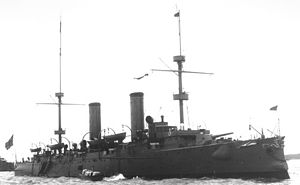 Chinese cruiser Hai Chi
| |
| Class overview | |
|---|---|
| Name | Hai Chi class |
| Builders | Armstrong Whitworth, Elswick, Tyne and Wear, United Kingdom |
| Operators | |
| Preceded by | Hai Yung class |
| Succeeded by | Chao Ho class |
| Cost | £336,659 |
| Built | 1896–1899 |
| In commission | 1899–1937 |
| Completed | 2 |
| Lost | 1 |
| Retired | 1 |
| General characteristics | |
| Type | Protected cruiser |
| Displacement |
|
| Length | 129.2 m (423 ft 11 in) o/a |
| Beam | 14.2 m (46 ft 7 in) |
| Draught | 5.45 m (17 ft 11 in) |
| Propulsion | 2 shafts, 4 Hawthorn Leslie VTE engines, 12-cylindrical boilers, 17,000 bhp (12,700 kW) |
| Speed | 24.15 knots (27.79 mph; 44.73 km/h) |
| Range | 8,000 nmi (15,000 km) at 'economical speed' |
| Complement | 400 |
| Armament |
|
| Armour |
|
The Hai Chi class (Chinese: 海圻級; pinyin: Hǎi Qí jí; Wade–Giles: Hai Chi ji; lit. 'Sea Boundary class')[citation needed] was a class of two protected cruisers built for the Qing Dynasty from 1896–1899. The Hai Chi class was ordered shortly after the conclusion of the First Sino-Japanese War from the United Kingdom to replace the catastrophic losses of the Beiyang Fleet. The Hai Chi class would remain one of the largest ship classes commissioned by China until the Cold War. The Hai Chi class would go on to serve in the Republic of China Navy through the National Protection War, World War I, the Second Zhili–Fengtian War, and the Northern Expedition.